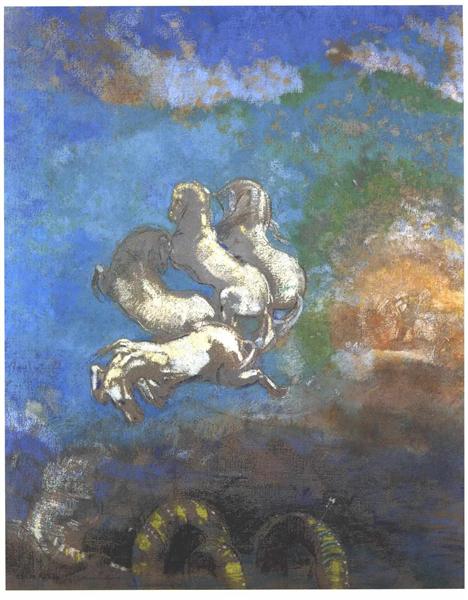Beskrivning
Odilon Redon, one of the most prominent representatives of symbolism and the artistic avant-garde of the late 19th and early 20th centuries, presents in his work "Apollo's Chariot" (Apollo's Chariot, 1914) a fascinating exploration of classical mythology, color and form. In this painting, the artist turns the representation of Apollo, the god of the sun, into a vehicle to express not only physical light, but the luminosity of thought and emotion, central elements of his poetics.
The composition is characterized by the dynamism that emanates from the central figure representing Apollo, surrounded by an explosive play of colors and shapes. His chariot, which seemingly glides across an ethereal background, is depicted in a stylized form, fusing characteristics that evoke both physical and transcendental movement. The fluid, organic lines that Redon employs reflect his mastery in balancing symbolism with rich visual representation. In the chariot, which is not presented in a conventional manner, the fusion between mythology and the symbolism of light becomes a splendid dialogue, revealing the connection between art and spirituality.
The colors in “Chariot of Apollo” are vibrant and create an almost surreal atmosphere. The yellow and gold hues emanating from Apollo contrast with the darker background, creating a luminous halo that highlights his divinity. Redon is known for his bold use of color, and in this work he does not disappoint; the subtle nuances suggest a dreamlike atmosphere, where reality is diluted in the mist of fantasy. The palette alludes to both the connotations of gold and sunlight, suggesting not only visual splendor, but also Apollo’s essential role as a source of wisdom and truth.
A fascinating aspect of this work is the way in which Redon approaches the figure of Apollo without the more typical accompaniments of classical iconography, such as horses or natural elements that usually generate a sense of movement. Here, Apollo becomes the pure image of the artist as creator, symbolizing the vital impulse of artistic creation itself. This emphasis on the divine figure suggests a deep reflection on the relationship of the human being with the divine, a recurring theme in Redon's work.
When looking at Chariot of Apollo, it is relevant to place this painting within the broader context of Redon's work and his time. Although Redon began his career in a period marked by Impressionism, his evolution toward a more intense and symbolist palette places him at the forefront of a movement that seeks to transcend the visible, moving closer to the psychological and emotional. Similar works in his repertoire share this focus on the mythological and symbolic, reflecting his concerns with the duality of existence and the search for truth beyond the tangible.
"Chariot of Apollo" is shown not only as a centerpiece within symbolism, but also as a meditation on the function of art and its ability to connect the everyday with the eternal. Through his ability to transform ancient myths into contemporary visions, Redon invites the viewer to contemplate not only aesthetic beauty, but also the depth of meaning that art can offer. In this sense, the work not only stands out for its external beauty, but for the rich complexity of the ideas it evokes, taking us on a journey that transcends time and space.
KUADROS ©, a famous painting on your wall.
Hand-made oil painting reproductions, with the quality of professional artists and the distinctive seal of KUADROS ©.
Painting reproduction service with satisfaction guarantee. If you are not completely satisfied with the replica of your painting, we will refund 100% of your money.

